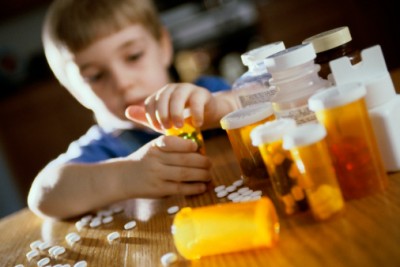
Every year, thousands of children accidentally ingest prescription drugs. However, too few people take the necessary precautions to protect children from poisoning from medications that do not have child proof cap.
A new nationally representative study of 1,006 U.S. adults by Consumer Reports Best Buy Drugs found that only 2 in 10 people who have medications, such as opioid painkiller pills, stimulants used to treat ADHD (attention deficit hyperactivity disorder), or sedatives, keep them locked up.
This may help explain why every year about 60,000 children under 5 years of age accidentally ingest these dangerous medications and end up in the emergency room, according to data from the Centers for Disease Control and Prevention (CDC).
It’s important that today, on National Medicine Cabinet Spring Cleaning Day, you learn more about the dangers of prescription drugs and find out the best ways to keep them out of your children’s reach.
How Poisoning Occurs
Pills and liquid medications end up in the hands of children when these products are lying around the house, left on the kitchen counter or on the bedside table to be used later, says Dan Budnitz, M.D., M.P.H., director of CDC’s Medication Safety Program.
Parents don’t take the necessary precautions to store them safely, or assume that child proof cap and safety devices will keep them out of reach, he says.
In addition, parents underestimate how harmful it can be for a child to ingest just a single pill, Budnitz says. «For example, for some long-acting opioids a single pill can contain a lethal dose for a child,» he explains.
Tablet opioids such as hydrocodone (Vicodin), oxycodone (Percocet) and buprenorphine (Suboxone) are among the medications most likely to be accidentally ingested, followed by anxiolytics such as clonazepam (Klonopin) and lorazepam (Ativan), Budnitz says.
These drugs can cause children to lose consciousness or even stop breathing, and may trigger seizures. If any of these things happen to your child, or he or she becomes overly drowsy, confused, has difficulty breathing or is not breathing, call 911 immediately.
Then check your child’s mouth and remove all the pills. Take the bottle and remaining pills with you so that emergency personnel can identify the pills and give the best possible treatment or antidote.
If they suspect that the drug involved may be an opioid pain reliever, the emergency team can administer naloxone, a drug to reverse the effects of the opioid. But you should still take the child to the emergency room for further evaluation and treatment, if needed.
Even over-the-counter (OTC) pills can be dangerous.
Acetaminophen (in Tylenol and other products), the commonly used pain reliever and fever reducer, is one of the most frequently accidentally ingested OTC medications. When children take too high a dose, it can cause liver damage or liver failure.
These risks are why CDC recommends that all medications be treated as if they were potentially hazardous chemicals, have child proof cap, and always be stored or locked out of children’s reach.
To reinforce the recommendations, the CDC recently introduced the Up and Away initiative, which reminds people to never leave pills or medicine bottles lying around on tables, nightstands, kitchen counters, in handbags, or in coat or coat pockets. And you should never tell children that your medicines are «candy».